1999 with Nick: Best Cinematography Falls on "Cedars"
 Tuesday, February 4, 2020 at 4:00PM
Tuesday, February 4, 2020 at 4:00PM This week, in advance of the Oscars, Nick Davis is looking back at the Academy races of 20 years ago, spotlighting movies he’d never seen and what they teach us about those categories, then and now...
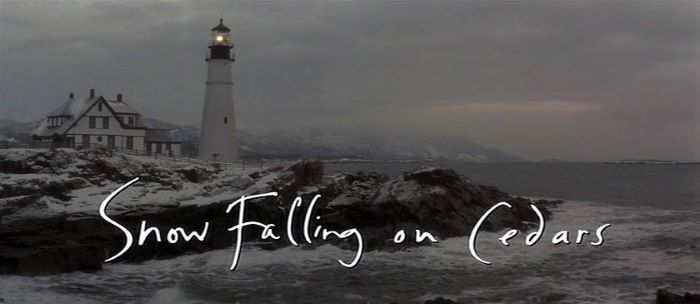
Spotlight Movie: Snow Falling on Cedars
Today's case study from the 72nd Academy Awards is a less auspicious instance than yesterday's of a movie sneaking onto Oscar's ballot with just one nomination. I'd also call it an example of good filmmaking that, in context, arguably constitutes bad filmmaking, or at least disappointing and misguided filmmaking. Cinematographer Robert Richardson is not the exclusive or even the primary defendant in the case I’m going to make. He was probably executing to the best of his ability the mandates of a director and a producing team intent on the picturesque. Still, I’m not sure we needed to reward him for following such dubious orders. And now, as so often in this movie, we flash back...
Scott Hicks's Snow Falling on Cedars was an extremely This Had Oscar Buzz feature that slipped into theaters around Christmas and was gone within a month. Hopes had clearly run higher for this adaptation of David Guterson's mega-selling, award-winning novel, which had been ubiquitous on airplanes and subways during the five preceding years. The director, Australia's Scott Hicks, probably beat some stiff competition for this job, even though it's hard to discern any connecting threads with his only notable prior success, the Oscar-winning Shine. Cedars’s screenplay is credited jointly to Hicks and Ronald Bass, an Academy Award winner early in his career for Rain Man and an apparent actressexual, having written big hits for Julia Roberts in three different genres (Sleeping with the Enemy, My Best Friend's Wedding, and Stepmom) as well as vehicles for Debra Winger (Black Widow), Meg Ryan (When a Man Loves a Woman), Michelle Pfeiffer (Dangerous Minds), Demi Moore (Passion of Mind), and Hilary Swank (Amelia). The most curious fact of Bass's career—which you may see, on his part, as an incongruous, displacing overreach or a welcome expansiveness of interests—is how often studios called up this particular white dude to adapt bestselling books into major projects for women of color: The Joy Luck Club, Waiting to Exhale, and How Stella Got Her Groove Back. The first of those, in its pathos-heavy approach to history and what some executive somewhere probably imagined as "Asian American stories," in the broadest of strokes, is the most obvious precursor for this gig on Bass's CV.
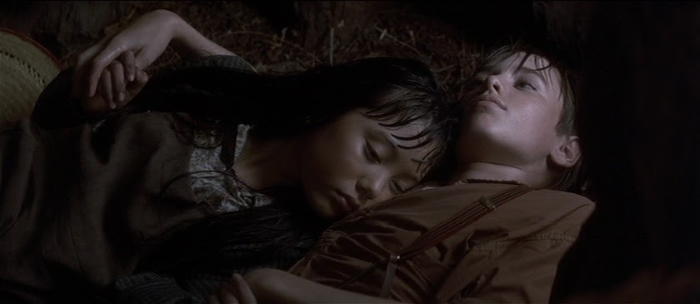
As a film, Snow Falling on Cedars doesn’t work all that well, trying for something close to Puget Sound, mon amour but insufficiently nimble with editing or rich with character, and infinitely more timid about the relevant histories. I was that one English major in the 1990s who didn’t read the novel, so I can’t compare Guterson’s structure to the screenplay’s constant time-shifting and its addiction to vague mysteries within every plotline. Of these many stories, two reign supreme. In the late 1930s or early 1940s, young Ishmael Chambers (Reeve Carney, not yet turning off the dark) falls in love with Hatsue Imada (Anne Suzuki), a neighbor and schoolmate on a fictional Pacific Northwest island. It’s a Secret Love, because Ishmael is white; within this U.S. enclave, Hatsue and her Japanese American family are not afforded that status. They sneak as often as they can into a large hollow beneath a cedar tree, for some weirdly staged, silhouetted make-out sessions. So, that’s your Past narrative. In the Present, which is 1954, Hatsue’s Japanese American husband Kazuo (The Fast and Furious star Rick Yune in his feature debut) has been accused of murdering a white fisherman named Carl Heine (Eric Thal). Motives seem light, though Carl may have participated in pushing Kazuo and his family permanently off the land that belonged to them before they were deported and incarcerated in Japanese “internment” camps amid post-Pearl Harbor national hysteria. Kazuo now faces trial, one that enmeshes every Hollywood actor who, earlier in the 1990s, auditioned for the role of Jack Skellington but lost out to a claymation figure: Richard Jenkins, James Cromwell, James Rebhorn, Zeljko Ivanek, Max von Sydow. The now-grown Hatsue (Youki Kudoh of PIcture Bride and Jim Jarmusch's Mystery Train) watches tearfully as the courtroom stands staunch against her family, save for von Sydow’s eloquent and charming defense attorney. The now-grown Ishmael (Ethan Hawke), a reporter like his father (Sam Shepard, another Skellington), watches the proceedings from the balcony, though he just as often stares at Hatsue, for whom he obviously still pines.
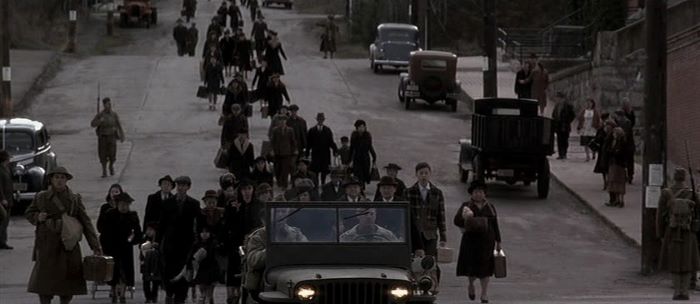
That’s a lot of plot. I just want to point out two details in my summary that are not coincidences, but should give you pause. One is that the entire, sordid history of Japanese Americans’ incarceration in WW2-era camps, briefly invoked midway through the last paragraph, is only chronologically the “center” of the film. As executed, it feels like an especially bleak transitional passage, figuring heavily into plotlines on either side that are manifestly less urgent. From the Manzanar camp, Hatsue will finally bow to her family’s insistence that love with a white boy is impossible, and she will write the letter that breaks off their relationship. The deportation fosters the conditions for the land dispute that itself plays as a gummy, weakly dramatized backstory to the murder plot driving the jury trial. But the mass-scale violence of deportation and incarceration itself (the more demure term “internment” has been increasingly retired) is staged rather briefly, with no clear point of view or palpable anger. Hicks’s mounting of this horrific chapter of U.S. history broadcasts what I can only call a respectful mourning for the suffering of people we mostly don’t know. You cannot remotely allege that the film suppresses these events, but you also can’t imagine why this is mere “context” for the amorous adolescent fumblings that precede it and the guess-what-he-didn’t-do-it legal drama to come. The thinness and meekness of this representation is all the more glaring if you watch Emiko Omori’s documentary Rabbit in the Moon, another 1999 premiere, much more in touch with the travesties but also the complexities of incarceration, including their corrosive effects within Japanese American communities.
Meanwhile, Ishmael, a vestigial add-on at the end of my plot summary, and by all rights the least interesting person with the least crucial positioning in the overall narrative, is for some reason the main character in Snow Falling on Cedars. Ethan Hawke gives a flat, unengaging performance, partly because the script conceives so little for him to do besides mope and observe. The film refuses to delve into aspects of Ishmael’s psyche that might make him interesting at the cost of making him dislikable: is he hoping Kazuo will be convicted, so he can reconnect with Hatsue? Does a part of him see the struggles of the absurdly-sidelined Kazuo and the under-explored Hatsue as comeuppance for her giving up on her past love with Ishmael? Does Ishmael truly have none of the anti-Japanese sentiment that has erupted across the island in the wake of this case, itself an obvious but shaky stand-in for the events of the war? All I can tell you is that Ishmael will eventually undertake some belated, not-incredibly-difficult sleuthing that will help swing the case toward exoneration, and every Japanese American person in the court will gaze on him with silent, worshipful gratitude. Because he always sits in the balcony, they’ll even get to gaze up at him, and Hicks will hold on that moment for a nice, long while.
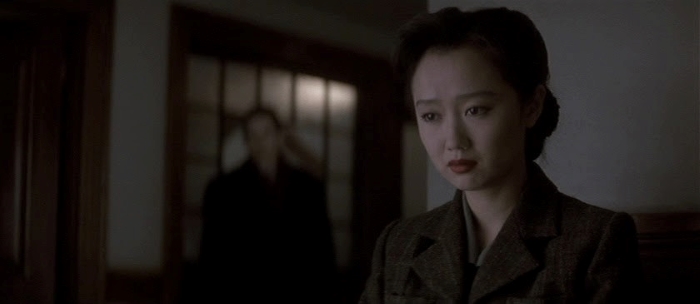
Understandably, the Academy wasn’t wooed by any of this, limiting a film that seemed on paper like an Oscar juggernaut to just one nod, for Best Cinematography. (Hopefully the Cedars people exchanged consoling telegrams with the Angela’s Ashes team, similarly restricted to Best Original Score.) It’s easy to say about this kind of film, “It didn’t work for me, but at least it was beautifully shot.” Critics’ groups in Chicago, Dallas, Florida, and Las Vegas felt so strongly this way that they gifted Robert Richardson their Best Cinematography prizes that year. Only the Florida group offered a joint citation with Richardson’s work on Bringing Out the Dead, his second collaboration with Martin Scorsese, in what soon became a major creative alliance.
In the lingo of the plodding courtroom drama, I have no objection, your Honor, to the defense’s claim that the photography of Snow Falling on Cedars is beautiful. Richardson maintains a palette of silver, gray, black, and white throughout, with just enough color to distance Cedars from any attempt at “period” monochrome. The argentine look of the movie clearly relates to its misty Puget Sound setting, especially with a major snowstorm headed toward the island as Kazuo’s trial nears its culmination. Established powerfully in the movie’s opening shots, as Carl’s and Kazuo’s boats fatally encounter each other in a night of dense fog over slate-colored ocean, that palette’s persistence can also imply that Snow Falling on Cedars and the society it portrays somehow remain stuck in that moment. That is, whatever transpired on that dark night that left Carl dead and Kazuo in jail has made the possibility of alliance, neighborliness, and co-citizenship between white Americans and Japanese Americans seem unreachable, maybe even undesirable, despite so many years when it was a local norm. The script—which reaches its unambiguous peak with Max von Sydow’s beautifully performed, impassioned plea for a better America—will eventually try to escape this environment of paralysis and distrust. The lighting attempts no such escape, staying committed throughout the 1954 narrative to its grays, black, and harsh white glares. The lush greens of childhood romance remain a distant memory.
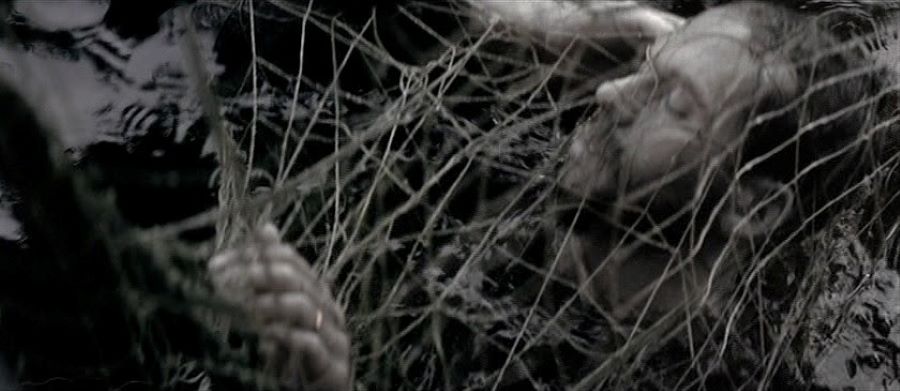
So, yes, the cinematography is beautiful, and its choices bear some thematic resonance. But why is it beautiful? What aspect of this tale about bigotry, legal railroading, theft, disinheritance, doomed love, and mass incarceration benefits from being pretty, and in the especially glossy, sleek, high-sheen way that Snow Falling on Cedars is pretty? I’m not asking for gratuitously ugly photography, since the events in the script are ugly enough. Still, I’m suspicious of the way that Snow Falling on Cedars, which as written and as directed has enough trouble facing and centering the nastiest facts of its narrative, seems eager to distract us with the palliating spectacle of “craft.” I’m using that word in the exact way that too many critics use it, gesturing to a pleasant aesthetic experience without indicating specifically what was pleasant and what are the thematic and political ramifications of making it pleasant. D.A. Miller wrote the definitive denunciation of “craft” in a diatribe I adore, without always agreeing, about Ang Lee’s weird determination to turn Annie Proulx’s ugly-beautiful story Brokeback Mountain, where the fundamental fact is poverty, into a beautiful-beautiful, well-“crafted” movie where the core value is romance. Brokeback Mountain, an infinitely better movie than Snow Falling on Cedars, at least has the wherewithal to shift its aesthetics from its first to its second half and is full of cinematic virtues, even if I agree with Miller that they aren’t always the right virtues for this story. Snow Falling on Cedars is a duller, more dire case of several painful histories being uniformly prettified for no credible reason.
And so, in all those needless reaction shots on Ethan Hawke’s Ishmael watching things happen instead of making things happen, we are invited to enjoy the way his cheekbones are illuminated by Richardson’s key light. Youki Kudoh’s Hatsue, deprived of the level of interiority or the amount of dialogue that a richer version of this story would furnish, can become a decorous object in visual terms as well as narrative ones. Even the hauling of a water-logged corpse out of a salty ocean is gorgeous. The encroaching snow storm around the courthouse can be lit with the power of a thousand coffee-table books. I admit that was probably quite difficult, given Cedars’ commitment to inky darkness in the nighttime scenes, and its ability to balance high-contrast images with low-contrast ones, without seeming to break visual character. Still, I’m not sure I see the point. The one time I was eager to see something beautiful for beauty’s sake, when Hatsue and Kazuo enjoy a steamy night in bed—a welcome blow against the near-constant desexualizing of Asian Americans on screen, except when pinioned into opposite, Orientalist stereotypes of exoticized voracity or submissiveness—suddenly it’s too dark to see anything! Compare that (semi-)visual treatment of a coupling that is crucial for this narrative to the indelible if differently distorted lensing of a sex scene between white characters that the script doesn’t even require, and you start to catch a sinister if familiar drift.
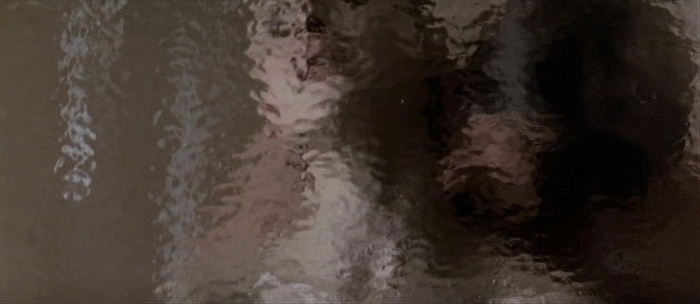
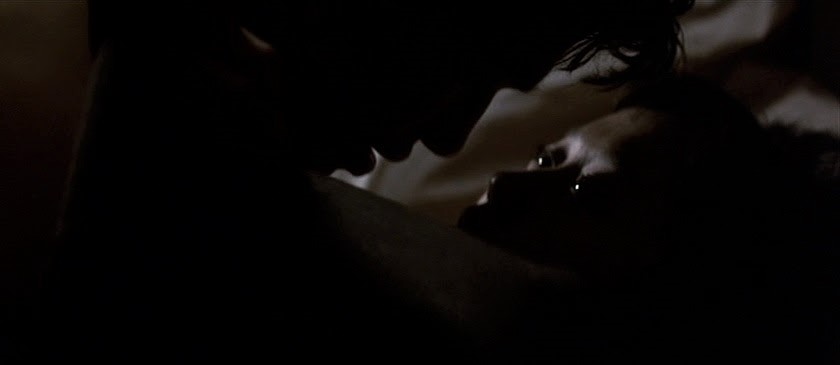
If this nomination happened today, one might grasp it as a reflex gesture on behalf of a cinematographer that Oscar clearly loves. This was Richardson’s fourth nomination in a tally that just reached the double digits, care of his tenth mention for this year’s Once Upon a Time...in Hollywood. Interestingly, Cedars marks the only time Richardson has made it to the ballot for a movie that wasn’t directed by any of his three chief collaborators, Oliver Stone (11 films), Scorsese (7), or Tarantino (6). Those auteurs count for over half of the 45 features, fiction or documentary, that Richardson has lensed. Aside from two pairs of films for John Sayles and Errol Morris, and an upcoming repeat for noted cineaste Andy Serkis (!), he’s been a one-and-doner so far with every other director on his résumé, including Penelope Spheeris (Dudes), Rob Reiner (A Few Good Men), Barry Levinson (Wag the Dog), Robert Redford (The Horse Whisperer), Shekhar Kapur (The Four Feathers), Marc Forster (World War Z), and Ben Affleck (Live by Night). Several of those projects clustered around the turn-of-the-century period, as Stone’s career radically downshifted, Tarantino hadn’t yet rung him up, and Scorsese was banging away at Gangs of New York with previous standby Michael Ballhaus. Given the eight-year Oscar drought that interceded between Richardson’s win for lensing JFK and this Cedars nom—an interval in which the ASC nominated him three times, for A Few Good Men, Heaven & Earth, and The Horse Whisperer, and everybody blanked him for god-level work on Natural Born Killers, Casino, and Nixon—he was hardly the AMPAS staple by 1999 that he’s since become. I’m also not positive how to quantify Richardson’s popularity among his peers, given that he’s been on ASC’s ballot 11 times but never won, compared to three prizes from the Academy’s general membership.
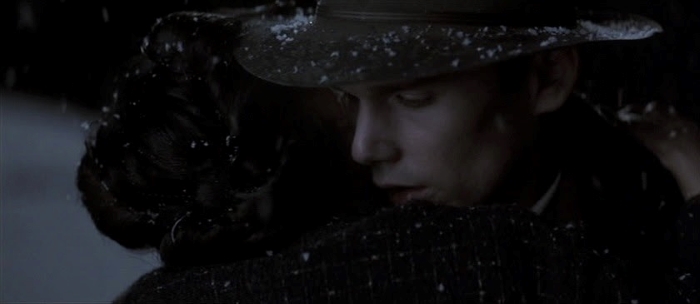
There’s probably no reason to overthink any of this. I suspect Snow Falling on Cedars got nominated for Cinematography because, for better or worse, it is pretty. I’d personally have urged voters toward Bringing Out the Dead instead, where Richardson’s camera is astoundingly mobile, and febrile with reds, whites, blacks, double-exposures, gangrenous yellows and greens, and neon haloes that capture the coked-up mania of Nicolas Cage’s frenzied ambulance driver. Somehow, all that justifiable grandiloquence does not occlude the more mundane darkness in the lives of other New Yorkers, most of them ailing in many senses at once. But beauty is beauty, I guess, and not everybody wants to “look closer,” despite the injunctions of this category’s eventual victor, American Beauty, to do just that. Even American Beauty, of course, doesn’t want us to look that much closer. And the Cinematographers’ branch is as guilty as any of us of asking one, narrow question while filling out their ballots, the same question that the Evil Queen can’t stop posing (while posing!) in Snow White and the Seven Dwarfs: “Who’s the fairest of them all?”
P.S. about this year
Obviously, Oscar voters join legions of moviegoers in admiring delicious pictures or big logistical feats as ends unto themselves, even when they don’t seem all that well-attuned to the narrative at hand: see Roger Deakins’s nomination and likely win this year for the arbitrarily “single-take” 1917, a slot I’d have loved to bestow instead on literally dozens of other competitors. I’ll isolate one in particular, Mike Leigh’s Peterloo, shot by Dick Poop Pope, because it’s a perfect counterpoint to the qualms I’ve raised about Snow Falling on Cedars. That movie, too, is about the ugly run-up to even uglier historical events, but it manages to be quite inviting to the eye without “prettifying” a narrative that rightly refuses any such approach. Pope photographs every face in Leigh’s typically massive ensemble with nuance and specificity, whereas Richardson, like Hicks, does not always manifest a clear handle on several of his actors or characters. There’s thought in Peterloo’s framings and an apt blend of the painterly and the dismal in its palette and compositions.



Reader Comments (9)
It seems to me that the cinematography Oscar goes through phases. For a time, it went to the prettiest movie. It also went through a "most" phase. Now it's in a phase of technological achievement. There's some crossover between the phases, but the trends seem pretty clear, so the nod for Snow Falling on Cedars has never surprised me; it's very pretty cinematography.
Cash -- that's a great point. I think we're still in the technically impressive time frame but i hope we can enter a new phase that is neithr about prettiest or most technically difficult and it's "most expressive"
17-year-old me adored the novel and then the film in quick succession; 37-year-old me is yet to change his mind on the subject, despite your formidable powers of analysis and eloquence, Professor Davis (which I have been reading and admiring in general for years now). Thanks are due, at least, for bringing SFOC to attention so that more viewers will hopefully be encouraged to make their own minds up about it.
While we’re talking cinematographers, I noticed your recent praise for Geoffrey Simpson’s work on SLEEPING BEAUTY and OSCAR & LUCINDA. As an Australian myself, such acclaim directed our way is most welcomed and valued - but I feel duty-bound to go further by encouraging you to arrange a viewing of both Simpson’s first fictional feature credit CENTRESPREAD (low-budget futuristic soft-core nonsense, but directed in a relatively artful and ambitious manner by MAD MAX editor Tony Paterson) plus Vincent Ward’s quite marvellous THE NAVIGATOR: A MEDIAEVAL ODYSSEY, in which Simpson and the NZ film industry manage to visually honour the memory and influence of past masters while crafting their own wildly successful idiosyncratic vision. (Umbrella Entertainment’s website should carry them both, if you’re interested.)
P.S. Rick Yune, not Cary-Hiroyuki Tagawa, played Kazuo.
Richardson has been doing the same type of cinematography for Stone and Scorsese over and over again. This post and his sunsets in the Tarantino movie are good reminders that he can do other stuff.
@Cash: I agree about those phases among the winners, which is why it's nice to see different kinds of cinematography included among the nominee fields. Last year, for example, I was glad to see the Star Is Born mention even though it's not the kind of thing that's won in quite a while. I also liked the 1999 nominees and the win for Beauty, since it's not a typical Cinematography winner and is crucial to the movie working as well as it does. Who would you have voted for among Beauty, Cedars, End of the Affair, Insider, and Sleepy Hollow?
@F.T.: Thank you for ALL of this: the great movie suggestions, the gracious compliments, and the snag on that extremely embarrassing goof, which Nathaniel has since fixed. The last time I tried to see The Navigator I couldn't find it on any streaming services, and it's very elusive on physical media in the US. But Google Play now seems to have it for rental, so I'll loop back! Again, thanks for this great response.
@Peggy Sue: This is why it's so great to see regular collaborators shake things up sometimes. I agree that, whatever my objections about how Cedars is shot, it showcases aspects of Richardson's artistry that his frequent directors don't really call up much. I also agree with you that Once Upon a Time... is a real step forward in his work with Tarantino, which hadn't excited me much up to this point. (That Hateful Eight nomination from Oscar was especially generous... and, as with Django, it stood out to me that ASC wasn't as impressed.)
The novel is one of my favorites. Guterson gets at something honest and real. It's been so long since I've seen the film--this article makes me wanna give it another go.
@Nick: I haven't seen The End of the Affair, and it's been 15-20 years since I've seen American Beauty, The Insider, and Sleepy Hollow. I have good impressions of all their cinematography, but not a lot of detailed memories. I remember the tight framing and intense close-ups of The Insider. I remember the eeriness of Sleepy Hollow, but I tend to recall the production design more than the cinematography.
I saw Snow Falling on Cedars more recently (4-7 years ago, maybe), and its lush visuals were the most obvious, memorable part of the movie to me. I found your mention of Richardson's ASC nod for The Horse Whisperer interesting, because that's another film where I immediately think of its beautiful photography more than anything else.
I wouldn't feel comfortable picking a winner for '99 without watching them all again. You said you liked American Beauty's win, but would it have been your first choice? What do you think about all the nominees?
@brookesboy: I've had it on my shelf forever, and am totally interested to try it. Guterson evidently had significant input into the movie, but studios always say that, don't they? I wonder how he felt about it. (Hawke, for one, has spoken coolly about the finished product.)
@Cash: I haven't seen Sleepy Hollow since it was in theaters, so I'm curious to see that one again. I really find this race hard to decide, since Beauty and Insider both demonstrated such visual finesse in genres that often don't bother, and Sleepy Hollow was so atmospheric and technically sophisticated, and End of the Affair has a gorgeous look as well as a suite of meaningful approaches to focus and depth-of-field that are important to the story, at least until the whole movie gets slicker and simpler in the later stages. All good nominees, in my opinion, even if my ideal list would be large enough to include Eyes Wide Shut, Bringing Out the Dead, The Talented Mr. Ripley, Boys Don't Cry, and maybe All About My Mother. In a totally different aesthetic, I'd probably also push for Rosetta. So I really have no idea how I'd vote, either. I totally get your hesitation!
WOW
Nick, you always have a LOT of things to say. I appreciate your time to write this and the search you made to share facts and information around the movies.
I feel a little disapoint about myself because i haven't watch this and the previous film of the posts of 1999 but i have to comment because cinematography is one of the aspects that i like to appreciate in a film.
I think that there is a tendency to reward "aesthetic" cinematographies (like American Beauty) and sometimes they forget to reward visually ineresting compositions
From 1999 i could easily named Sleepy Hollow as my favorite for that interest mix of colors and shadows that are totally according with the story but i would like that can have space to experimental works like the black-white and color contrasts from Pleasantville or the semi-erased textures of the Venezuelan film Amaurosis.
If in recent years are more black an white movies i think that is time to experiment with orher colors. I've already said it before but i want a sepia color movie please.